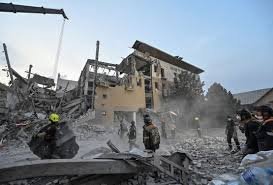Russia unleashed a large-scale drone and missile campaign across Ukraine overnight into October 22, 2025, leading to the death of at least six civilians — including two children — and widespread damage to power infrastructure. (Reuters)
The wave of attacks followed the postponement of a proposed summit between U.S. President Donald Trump and Russian President Vladimir Putin in Budapest, which many saw as a key moment for de-escalation. (Financial Times)
Assault on Kiev and surrounding regions
Russian forces fired 28 ballistic and cruise missiles along with 405 drones against Ukrainian targets, according to Ukraine’s air force. (Financial Times) The attack struck the capital, Kyiv, as well as nearby districts and other major cities. A drone strike on a kindergarten in Kharkiv killed one person and injured seven others – among them six children. (Financial Times)
In Kyiv, debris from intercepted missiles and drones littered residential areas. Fires broke out across several districts, including Desnianskyi, Darnytskyi and Pecherskyi. (Reuters) The city’s energy ministry reported emergency power outages in most regions, including the capital. (Reuters)
Why the timing matters
The attack came at a critical diplomatic juncture. A planned meeting between Trump and Putin was called off after Moscow declined a U.S.-backed ceasefire proposal. (Reuters) Ukraine’s President Volodymyr Zelenskyy said the strikes demonstrated that “Russia does not feel enough pressure” to pause hostilities. (The Guardian)
Analysts view the timing as strategic for Moscow: by opening a new wave of attacks now, Russia may seek to reinforce its leverage while Kyiv and its allies contend with deteriorating infrastructure and mounting civilian casualties.
What was hit and what it means
Here is a breakdown of key targets, impacts and implications:
| Targeted asset | Impact reported | Strategic implication |
|---|---|---|
| Residential / civilian areas in Kyiv & Kharkiv | Buildings damaged, children among dead; fires in high-rise units in Kyiv’s Dniprovskyi district rescued 10 people. (Reuters) | Heightened civilian harm raises war-crime concerns; increases domestic Ukrainian resolve and international pressure. |
| Energy infrastructure (power grid, gas & oil) | Ukrainian energy minister reported attacks caused widespread outages, including in Kyiv region and Poltava oil and gas facilities. (Reuters) | Disruption ahead of winter, strains public services and civilian morale, forces Ukraine to divert resources. |
| Kindergarten in Kharkiv | Drone hit, fire set, children evacuated, acute stress reactions reported. (The Guardian) | Symbolic escalation: hitting a preschool sends a chilling message and may influence international narrative. |
What happens next – 5 key considerations
- Diplomatic ripple effects – With the Trump-Putin summit shelved, the window for a negotiated ceasefire narrows. Ukraine is now more likely to seek deeper commitments from Western partners.
- Western military aid – Ukraine will emphasise the need for long-range strike systems and enhanced air-defence, citing this attack as evidence of the evolving threat.
- Winter readiness – Power outages ahead of winter pose a humanitarian risk. Western and Ukrainian planners must assess contingency resources for shelter, heating and repairs.
- Civilian-protection focus – Escalation targeting kindergartens and residential blocks may spur calls for stronger legal and monitoring frameworks under international law.
- Moscow’s messaging – Russia signals that it retains initiative and can strike at will. The assault likely serves as a message to Kyiv’s backers about the costs of delay or escalation.
What readers should pay attention to
- Tracking power-cut zones: Regions such as Kyiv, Poltava and Zaporizhzhia may face prolonged outages — residents and businesses should monitor local civil-defence bulletins.
- Aid-flow interruptions: With infrastructure under fire, humanitarian corridors and winter-relief logistics could be disrupted.
- Diplomatic statements: Watch for official shifts in U.S., EU or NATO posture following President Trump’s withheld summit and Ukraine’s response.
- Child-casualty reports: The inclusion of children among casualties adds a new humanitarian dimension which often drives international action.
- Air-defence capabilities: Whether Ukraine will receive upgraded systems (e.g., long-range interceptors) will influence how far Russian strikes can penetrate in coming months.
Trending FAQ
Q: How many people were killed in this wave of strikes?
A: Ukrainian officials confirmed at least six people were killed, including two children. (Reuters)
Q: Which cities were targeted?
A: Main strikes hit Kyiv and nearby districts, as well as Kharkiv (including a kindergarten). (Financial Times)
Q: How many drones and missiles were involved?
A: Reports indicate 405 drones and 28 missiles were used in the assault. (Financial Times)
Q: What caused the postponement of the Trump-Putin summit?
A: The meeting was shelved after Russia rejected a U.S.-proposed ceasefire and Ukraine indicated little progress in negotiations. (Reuters)
Q: What is the likely next step in Ukraine’s strategy?
A: Kyiv is expected to appeal to Western allies for advanced air-defence, advocate for increased sanctions on Russia and accelerate preparations for winter civilian protection.
Russia’s latest wave of attacks across Ukraine marks a sharp intensification of the conflict. With children among the fatalities, energy systems under fire and diplomatic pathways narrowing, the situation now demands urgent attention on multiple fronts — humanitarian, military and political. The developments over the next days will signal whether this marks a new escalation phase or a pivot point toward a broader push for stability.
